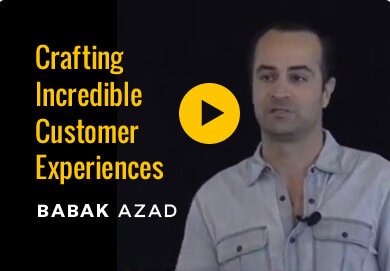If your business includes the following: 1) get customers; 2) make a profit from those customers; then this post is for you. While I’m being a bit tongue-in-cheek, I’m not kidding all that much. Because there are some fundamentals about how you manage your business model that transcend all business types.
In my recent posts, I’ve made reference to understanding the value of a customer. I think it is the single most important piece of information you need to have to run your business. This applies regardless of what category you place yourself in – direct response, brand, or anything else. And in a lot of the work I do with folks, I raise it early in our conversations not simply because it’s neat and interesting to have, but because:
- If you are running any paid media, you need to know the value of a customer to know if the media you run is working – and what “working” actually means
- It helps to ensure you actually understand your business model. As a unit economics model, it has to capture what actually shows up on the P&L, and in so doing, you figure out how much you make per customer. That is a lot more important than most people think. If you’re not making money, on average, on an individual customer, then you’re not going to make it up on volume…
- With this model, you create a way to understand the key levers in your business, which, AND THIS IS THE MOST IMPORTANT PART, helps you to determine what ACTIONS you take. Having a model that does NOT result in action means there’s something wrong with the model or you’re not using it correctly.
So what the heck do we mean by the value of a customer (or “Customer LTV”). I’ve seen so many different definitions:
- The revenues generated on a customer’s first transaction
- All the revenues generated by a customer regardless of timing
- Gross revenues less refunds/returns over the life of a customer
- Net revenues less costs (with varying definitions both of what each of those means)
To be clear, NO DEFINITION IS RIGHT OR WRONG. But what is crucial is that whoever is using the information knows what it means and is using the information in an appropriate manner.
So let me jump in to what I consider Customer LTV:
- For a given media source, what contribution margin does the average customer generate.
- For example, when you run branded search, what’s the value of that customer? When you run Facebook ads, what’s the value of that customer?
How, then, do you calculate contribution margin?
First, calculate Pre-Media Margin by taking all the revenues generated by a customer over their lifetime, adjusting for returns/refunds, customer cancellations and credit card declines (“Net Revenues”) less all the variable costs that are the direct result of those revenues. These may include physical product costs, merchant processing charges, shipping, warehouse/fulfillment expenses, customer care, server costs, and bad debt.
Net Revenues Less Variable Expenses = Pre-Media Margin
Then, include a desired margin on your revenues (more on this in a moment). The difference between the Pre-Media Margin and Target Contribution Margin is the amount you can pay to acquire a customer and still hit your goal. Usually the term “allowable” or “target customer acquisition cost” means the goal, and then the actual figure (media divided by customers) is CPO or CPA (Cost per Order / Cost per Acquisition).
Pre-Media Margin Less Required Profit = Target Customer Acquisition Cost / Media Allowable
Thus: Contribution Margin = Net Revenues Less Variable Expenses Less The Cost of Acquiring a Customer
Notice that by working to understand the value of a customer, you have backed into how you can afford to pay to acquire that customer. Which in turns allows you to manage your media in a more explicit and intentional manner. You now will have a way of determining what it means for your media (marketing) to be “working” or “not working”.
This is a very simplified view of a customer lifetime value model (also called a margin model):
I like to break down the numbers into front-end (first transaction) and back-end (subsequent transactions), seen below. What time horizon you use for the subsequent transactions is a bit of a business decision, based on cash flow requirements, risk associated with those revenues, etc.
(Note: this structure is not a proprietary one. Most of the top direct-response marketers use a version of it. You can also see how the folks at Digital Marketer use it here. Or if you want to dig in really hard, this is a great book about how to use metrics in your business.)
In the below example, imagine a marketer who signs up a customer for a trial offer and then upsells them into a subscription or continuity offer – these are clearly NOT their numbers, but anyone familiar with Proactiv, the anti-acne product, might have a model structured in this way. The company may be subsidizing the first bottle knowing that customers will buy a bunch more in the future.
In reality, the media cost should actually be part of the front-end because the marketer pays for the media on day 1 but has to wait some time in the future for those future sales to come in.
Cash Flow Implications
Unless you’re one of those fortunate marketers who has a ton of cash in the bank, even if you knew with a high degree of confidence that customers will generate a good amount of revenues (read: cash) in the 90, 180, or 360 days after their first transaction with you, you have to be sensitive to cash flow. Which will affect how aggressive you can be on going in the hole with new customers or how aggressive you can be with scaling your media.
This decision is business-specific. If you have a physical product business, you may need to pay for inventory well before your continuity orders kick in (or you may have great terms or a short lead-time that allows you to not have to carry that much inventory until you actually need it).
This is where information / digital products have an advantage, since often times one of the only/biggest investments is the creation of the product/service. And then of course the media spend to acquire the customer.
Below is very simplistic example to showcase the point for a physical products business:
- Before even running media, this physical product marketer has already paid out $2,000 for inventory.
- They are running a low-priced trial offer so they may not cover their initial expenses even when they’ve acquired customers.
- Perhaps they don’t pay for media right away but pay weekly, and perhaps the warehouse gives them 30 days to pay for work they’ve done.
- At that point the first set of continuity orders ship out and generates revenues/cash for the marketer. If this were a multi-pay offer, then that push out cash even further.
This post isn’t meant to focus on cash flow but you can see the implications on cash when running media. And it’s something that you have to model. You need to understand your model, so that you can pay your bills, based on when customers will be paying you.
For whatever reason, the 90-day breakeven seems to be a standard that many people I talk with use, but again, that depends on your model.
Target Margin
In the lifetime value model above, I used a return on revenues of 15%. This is another business-specific decision. While it is somewhat arbitrary, there are a few factors you want to consider when setting it.
- What are your business goals? If your goal is about pure customer acquisition and you don’t have a high burn rate, you might be able to run at a low/zero margin.
- Who would do this? Plenty of VC-funded companies run at negative margin, or if your play is about building a list to monetize, that strategy might push you to run this way.
- What is actually possible? As I’ve mentioned, one of the values of this unit economics model is to understand your business model. You may find that your revenues and cost structure don’t support the margin you thought was attainable. Kinda important to know.
- Balancing volume with margin – higher margins are always nice but you have to balance that with volume.
- This point is much more nuanced and doesn’t have a good scientific explanation. All I know is that it’s true.
- For each form of media and each campaign, there seem to be breakpoints where if you have an allowable above a certain number, you can jump your media spend. So while you might want to increase your target margin (thereby lowering your allowable), it might mean that you are making it more difficult to run at scale. Someone should always be looking to see how much media they think you can run based on different allowables/margins.
A More Exhaustive Analysis
Let’s dig deeper and look a specific model, a physical product (in this case a supplement marketer).
Before jumping in, I need to make something clear – these models apply for each media channel. If you only have 1 channel or don’t have the info to separate out different customers, use what you have right now, but start building the tools and systems to track customers from different places.
The values used below are for an average customer. Meaning, if everyone takes your $5 initial offer and 15% of the people take your 1st upsell which is $100, then your average order value is $5 + 0.15*100 = $20. For the back-end, it’s the same thing – the simplest way to calc that figure is to take all the back-end revenues generated by customers (typically we group them into cohorts based on the timing of their first transaction) and divide by the number of customers.
In this below example, you can see I’ve expanded the model to include more line items that are relevant for this business model. Let’s go through each step by step:
- The marketer generates gross sales, but some customers call to cancel their order right away and some credit cards don’t get correct authorization.
- That leaves shipped revenues, revenues associated with orders/customers where an actual product shipped out.
- A certain percentage of customers want refunds – I’ve assumed 10% for both front and back-end when in reality it’s rarely the same. Nor is it the same for customers who are getting their 2nd bottle versus their 7th one. Long-time customers, not surprisingly, have much lower return rates than newer customers.
- That gets us to net revenues.
- At this point, we need to deduct all the costs associated with these orders/revenues – the physical product, fulfillment and warehouse fees (which many people include in their product cost), shipping expense (UPS, Fedex, USPS, etc.), credit card processing, customer service, and bad debt assuming this marketer allows people to pay in installments.
- We are now at pre-media margin. And in this case, the marketer wants a return of 15% on their revenues, which means that as long as this marketer spends $48 or less to acquire an average customer (reflected in this model), they’ll do so.
Each of these line items can have further nuance, for example:
- There are warehouse costs incurred when customers return product, not to mention the product returned may or may not be salvageable.
- Cancels on the front-end are likely different than on the back-end.
- But wherever you are, and whatever level of detail you have for your business, start there as your baseline and then work to improve the information you gather.
To my prior point that this model should drive action, in addition to helping manage media, this marketer might identify an opportunity with reducing shipping expense. Not that it is easy to do, but if this marketer could decrease the average shipping costs for the back-end from $16 to $13, that would add $3 to their media allowable. And as so many folks before me have said, “He/She who can pay the most to acquire a customer, wins!”
This is a fictitious model, but if it were real, I would work with the team to understand what opportunities they have both to increase revenues and to create efficiencies in the cost structure, serving both the media allowable here as well as the broader P&L.
Other Business Models
Info Products
What about marketers who aren’t selling a physical product but rather are selling an information product, like an online training program?
Well, the process is the same, but the specific line items would be different. If it’s a pure info product, then there would be no shipping or warehouse fees, nor physical product costs. Some of those might be replaced with the cost of delivering the product – whether an e-book, or server and bandwidth fees associated with a membership area.
Lead-Gen
The same structure of the model works for lead-gen folks who are not managing to paying customers but to leads (names on a list, email opt-ins, etc.). The only difference is that the Target Customer Acquisition Cost needs to be multiplied by the percent of leads who convert to paying customers. That gets you a Target Cost per Lead
What about fixed costs – why are those NOT included?
Noticeably missing from these models are fixed costs, such as labor, rent, technology, and even product development costs (R&D for a product, the cost of developing a training program, etc.). I’m often asked why I don’t include them in the model. There are a few reasons:
- The goal of the model – often referred to as a “Margin Model” – is to understand the marginal revenues and costs associated with new customers. As such, it is very rare that an average, additional customer creates additional fixed cost requirements for a company.
- As you scale the business, you will likely need more resources to support the growing customer base, but this model is capturing the economics at the unit level, not at a macro level.
- Put more simply, acquiring and servicing a single additional customer doesn’t drive you to hire another person.
- In addition, these fixed costs mentioned above are often sunk costs – whether you generate 5,000 customers, 100,000 customers or 3 customers, for at least a period of time, you are already burdened with those expenses or you have already incurred them.
- Now, you absolutely need to run some analysis and look at your full P&L to know how many customers do you need, assuming you hit your target CPA, to breakeven when you factor in fixed costs, G&A, etc. – this is crucial work that I am not under-emphasizing. My focus right now is on this unit economics / margin model exclusively.
Interestingly, I get asked whether or not to include headcount in this model but no one ever asks whether investments in technology (servers, software, etc.) should be included. My response, in addition to the point above, is that you should look at your people similar to technology – they are investments in your company’s future.
Is it wrong to include any of these fixed costs in the model? No. But I would say that you’ll be under-cutting your allowable, and especially as you look to scale, you’re going to be holding yourself back from pushing as aggressively as you might ordinarily.
If you can’t tell, I’m pretty passionate about this topic. But not simply because I come from a quant background, but because I believe strongly that it is one of the crucial components of running any business.
You need to have someone who owns your model(s). And then have people who work with those analysts to identify points of leverage in the business and specific tests to run to optimize your business. The ROI on this is a no-brainer. Not to mention it might save your business.
Please leave a comment below because I’d like to hear what you think.






[…] In previous posts, after harping on about the importance of knowing the value of your customer, I detailed out how to measure customer LTV. […]